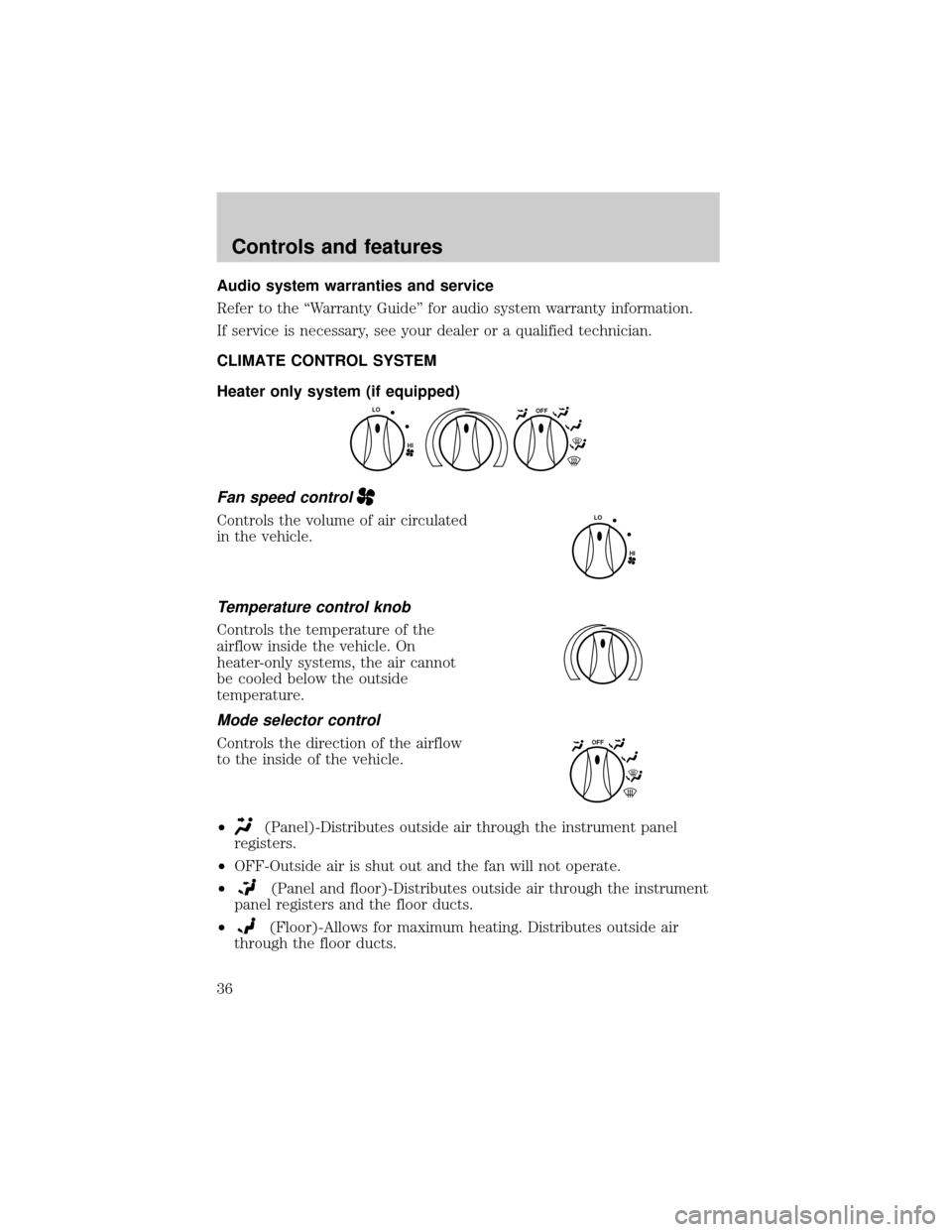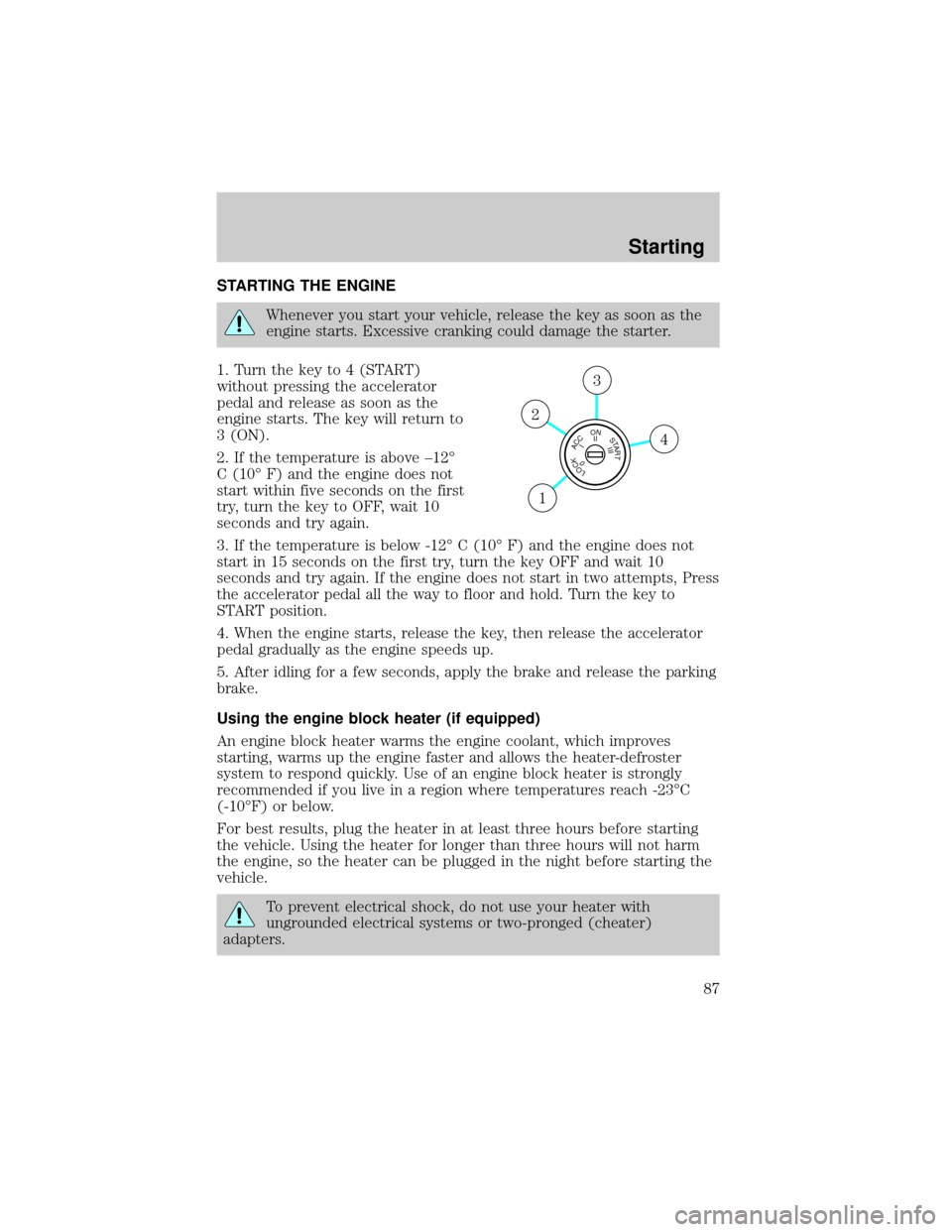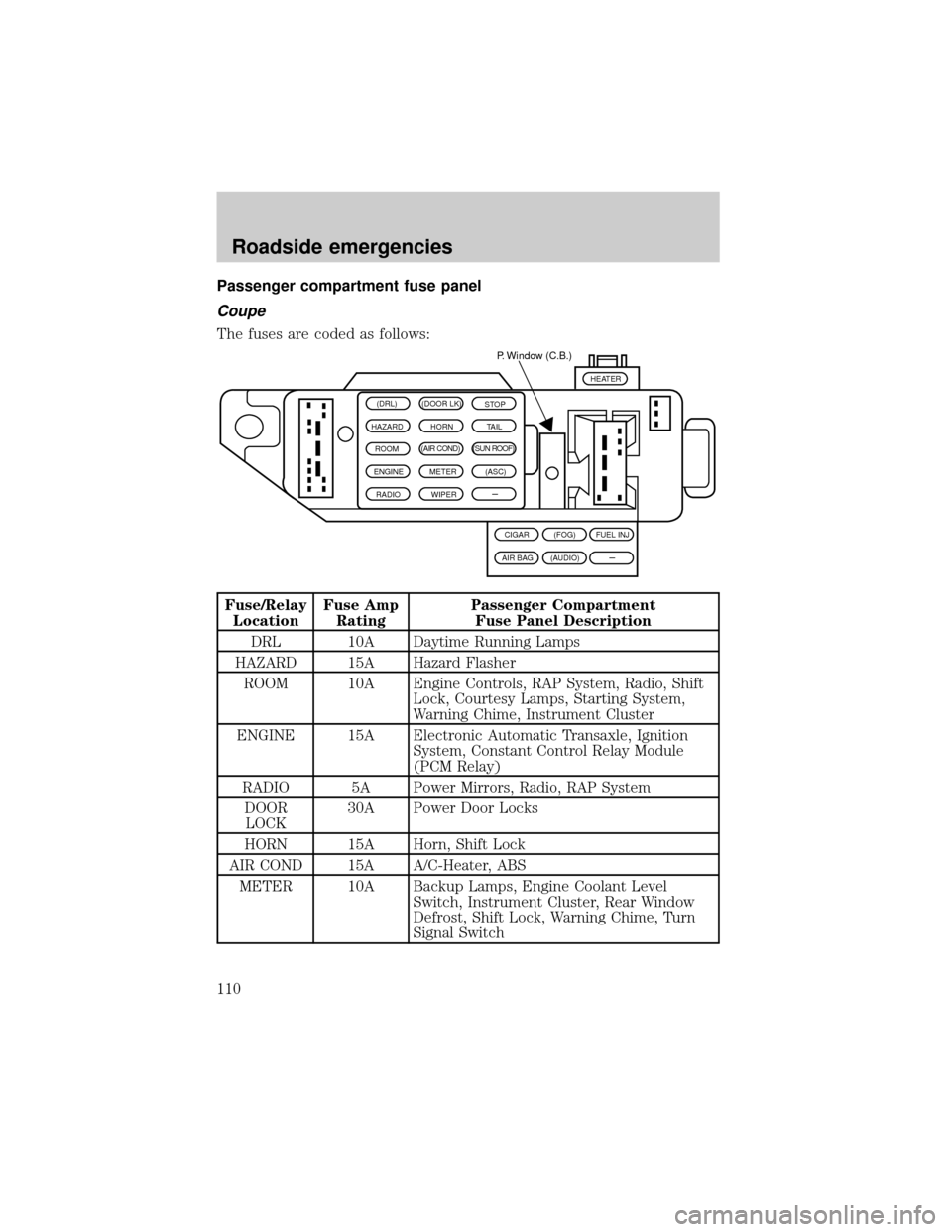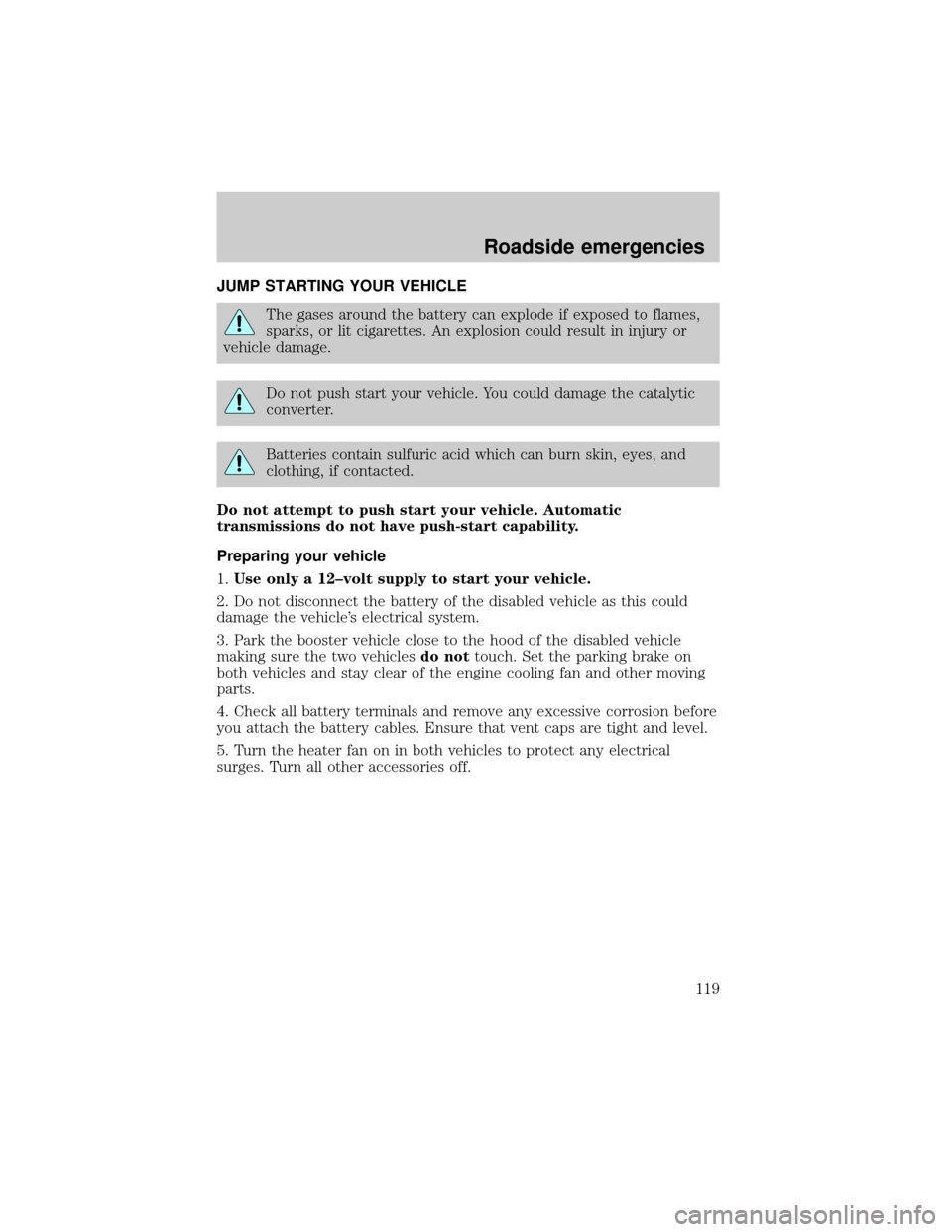2000 FORD ESCORT heater
[x] Cancel search: heaterPage 36 of 200

Audio system warranties and service
Refer to the ªWarranty Guideº for audio system warranty information.
If service is necessary, see your dealer or a qualified technician.
CLIMATE CONTROL SYSTEM
Heater only system (if equipped)
Fan speed control
Controls the volume of air circulated
in the vehicle.
Temperature control knob
Controls the temperature of the
airflow inside the vehicle. On
heater-only systems, the air cannot
be cooled below the outside
temperature.
Mode selector control
Controls the direction of the airflow
to the inside of the vehicle.
²
(Panel)-Distributes outside air through the instrument panel
registers.
²OFF-Outside air is shut out and the fan will not operate.
²
(Panel and floor)-Distributes outside air through the instrument
panel registers and the floor ducts.
²
(Floor)-Allows for maximum heating. Distributes outside air
through the floor ducts.
OFF
HI
LO
HI
LO
OFF
Controls and features
36
Page 87 of 200

STARTING THE ENGINE
Whenever you start your vehicle, release the key as soon as the
engine starts. Excessive cranking could damage the starter.
1. Turn the key to 4 (START)
without pressing the accelerator
pedal and release as soon as the
engine starts. The key will return to
3 (ON).
2. If the temperature is above ±12É
C (10É F) and the engine does not
start within five seconds on the first
try, turn the key to OFF, wait 10
seconds and try again.
3. If the temperature is below -12É C (10É F) and the engine does not
start in 15 seconds on the first try, turn the key OFF and wait 10
seconds and try again. If the engine does not start in two attempts, Press
the accelerator pedal all the way to floor and hold. Turn the key to
START position.
4. When the engine starts, release the key, then release the accelerator
pedal gradually as the engine speeds up.
5. After idling for a few seconds, apply the brake and release the parking
brake.
Using the engine block heater (if equipped)
An engine block heater warms the engine coolant, which improves
starting, warms up the engine faster and allows the heater-defroster
system to respond quickly. Use of an engine block heater is strongly
recommended if you live in a region where temperatures reach -23ÉC
(-10ÉF) or below.
For best results, plug the heater in at least three hours before starting
the vehicle. Using the heater for longer than three hours will not harm
the engine, so the heater can be plugged in the night before starting the
vehicle.
To prevent electrical shock, do not use your heater with
ungrounded electrical systems or two-pronged (cheater)
adapters.
LOCKACCONSTART0IIIIII4
3
2
1
Starting
87
Page 110 of 200

Passenger compartment fuse panel
Coupe
The fuses are coded as follows:
Fuse/Relay
LocationFuse Amp
RatingPassenger Compartment
Fuse Panel Description
DRL 10A Daytime Running Lamps
HAZARD 15A Hazard Flasher
ROOM 10A Engine Controls, RAP System, Radio, Shift
Lock, Courtesy Lamps, Starting System,
Warning Chime, Instrument Cluster
ENGINE 15A Electronic Automatic Transaxle, Ignition
System, Constant Control Relay Module
(PCM Relay)
RADIO 5A Power Mirrors, Radio, RAP System
DOOR
LOCK30A Power Door Locks
HORN 15A Horn, Shift Lock
AIR COND 15A A/C-Heater, ABS
METER 10A Backup Lamps, Engine Coolant Level
Switch, Instrument Cluster, Rear Window
Defrost, Shift Lock, Warning Chime, Turn
Signal Switch
(DRL) (DOOR LK)
STOP
HAZARD HORN
TAIL
ROOM(AIR COND) (SUN ROOF)
ENGINE METER(ASC)
RADIO
WIPER
–P. Window (C.B.)
(FOG) CIGAR
(AUDIO)
AIR BAGFUEL INJ
HEATER
–
Roadside emergencies
110
Page 111 of 200

Fuse/Relay
LocationFuse Amp
RatingPassenger Compartment
Fuse Panel Description
WIPER 20A Wiper/Washer, Blower Motor Relay
STOP 20A Stop Lamps, Brake Pressure Switch
TAIL 15A Exterior Lamps, Instrument Illumination
SUN ROOF 15A Power Moonroof
ASC 10A Speed Control
P. WINDOW 30A CB Power Windows
CIGAR 20A Cigar Lighter
AIR BAG 10A Air Bags
FOG 10A Fog Lamps, Daytime Running Lamps (DRL)
AUDIO 15A Premium Sound Amplifier, CD Changer
FUEL INJ. 10A H02S, Evaporative Emission Purge Flow
Sensor
BLOWER 30A CB Blower Motor Relay
Sedan
R. WIPER (DOOR LK)
STOP
HAZARD HORN
TAIL
ROOM(AIR COND)SUNROOF
ENGINE METER(ASC)
MIRROR
WIPER
–P. Window (C.B.)
(FOG) CIGAR
(AUDIO)
AIR BAGFUEL INJ
HEATER
–
Roadside emergencies
111
Page 112 of 200

The fuses are coded as follows:
Fuse/Relay
LocationFuse Amp
RatingPassenger Compartment
Fuse Panel Description
R.WIPER 10A Daytime Running Lamps, Liftgate
Wiper/Washer
HAZARD 15A Hazard Flasher, Engine Controls
ROOM 10A Remote Anti-Theft Personality (RAP)
Module, Radio, Shift Lock, Courtesy Lamps,
Starting System, Warning Chime
ENGINE 15A Air Bag, Engine Controls, TR Sensor
MIRROR 5A Power Mirrors, Radio, Remote Keyless
Entry (RKE)
DOOR
LOCK30A Power Door Locks
HORN 15A Horn
AIR COND 15A A/C-Heater, ABS
METER 10A Backup Lamps, Engine Controls,
Instrument Cluster, Rear Window Defrost,
Shift Lock, Warning Chime, Turn Signal
Switch
WIPER 20A Wiper/Washer, Blower Relay
STOP 15A Stop Lamps
TAIL 15A Exterior Lamps, Instrument Illumination
SUN ROOF 15A Power Moonroof
ASC 10A Speed Control
CIGAR 20A Cigar Lighter
AIR BAG 10A Joint Connector, Air Bag Diagnostic
Monitor
FOG 10A Fog Lamps, Daytime Running Lamps (DRL)
AUDIO 15A Radio
FUEL
INJECTOR10A HO2S, Evaporative Emission Purge Flow
Sensor
P. WINDOW 30A CB Power Windows
BLOWER 30A CB A/C-Heater
Roadside emergencies
112
Page 119 of 200

JUMP STARTING YOUR VEHICLE
The gases around the battery can explode if exposed to flames,
sparks, or lit cigarettes. An explosion could result in injury or
vehicle damage.
Do not push start your vehicle. You could damage the catalytic
converter.
Batteries contain sulfuric acid which can burn skin, eyes, and
clothing, if contacted.
Do not attempt to push start your vehicle. Automatic
transmissions do not have push-start capability.
Preparing your vehicle
1.Use only a 12±volt supply to start your vehicle.
2. Do not disconnect the battery of the disabled vehicle as this could
damage the vehicle's electrical system.
3. Park the booster vehicle close to the hood of the disabled vehicle
making sure the two vehiclesdo nottouch. Set the parking brake on
both vehicles and stay clear of the engine cooling fan and other moving
parts.
4. Check all battery terminals and remove any excessive corrosion before
you attach the battery cables. Ensure that vent caps are tight and level.
5. Turn the heater fan on in both vehicles to protect any electrical
surges. Turn all other accessories off.
Roadside emergencies
119
Page 191 of 200

Comfort and convenience
Air conditioner
Cargo nets
Cargo organizers
Engine block heaters
Travel equipment
Auto headlamps with daytime running lights (DRL)
Console armrest
Daytime running lights (DRL)
Electrochromic inside mirror with compass
Electrochromic inside mirror with compass and temperature display
Heavy-duty battery
Removable luggage rack
Removable luggage rack adapters
Soft luggage cover
Speed control
Protection and appearance equipment
Air bag anti-theft locks
Carpet floor mats
Cleaners, waxes and polishes
Flat splash guards
Front end covers (full)
Lubricants and oils
Molded splash guards
Molded vinyl floor mats
Rear decklid spoilers
Touch-up paint
Universal floor mats
For maximum vehicle performance, keep the following information in
mind when adding accessories or equipment to your vehicle:
Customer assistance
191
Page 195 of 200

Coolant
checking and adding ..............137
refill capacities .................141,175
specifications ...................176,177
Cruise control
(see Speed control) ....................43
Customer Assistance ................105
Ford accessories
for your vehicle ......................189
Ford Extended
Service Plan ............................182
Getting assistance outside
the U.S. and Canada ..............188
Getting roadside assistance ...105
Getting the
service you need ....................182
Ordering additional
owner's literature ...................192
The Dispute
Settlement Board ...................185
Utilizing the Mediation/
Arbitration Program ...............188
Daytime running lamps
(see Lamps) ................................41
Defrost
rear window ..............................40
Dipstick
automati
c transmission fluid ................143
engine oil .................................132
Doors
lubricant specifications ..........176
Driving under special
conditions
through water .........................104
Emergencies, roadside
jump-starting ..........................119
Emission control system ..........161
Engine .................................177,178
check engine/
service engine soon light ...........9
cleaning ...................................172coolant .....................................137
idle speed control ...................146
lubrication
specifications ...................176,177
refill capacities ........................175
service points ...................130,131
starting after a collision .........106
Engine block heater ...................87
Engine oil ..................................132
checking and adding ..............132
dipstick ....................................132
filter, specifications .........134,175
recommendations ...................134
refill capacities ........................175
specifications ...................176,177
Exhaust fumes ............................88
Floor mats ...................................52
Fluid capacities .........................175
Foglamps .....................................42
Fuel ............................................153
calculating fuel economy .......158
cap ...........................................155
capacity ...................................175
choosing the right fuel ...........156
comparisons with EPA fuel
economy estimates .................161
detergent in fuel .....................157
filling your
vehicle with fuel .......153,155,158
filter, specifications .........158,175
fuel pump shut-off switch .....106
gauge .........................................13
improving fuel economy ........158
low fuel warning light ................8
octane rating .............156,177,178
quality ......................................157
running out of fuel .................157
safety information relating to
automotive fuels .....................153
Fuses ...................................108,110
Gas cap (see Fuel cap) ............155
Index
195